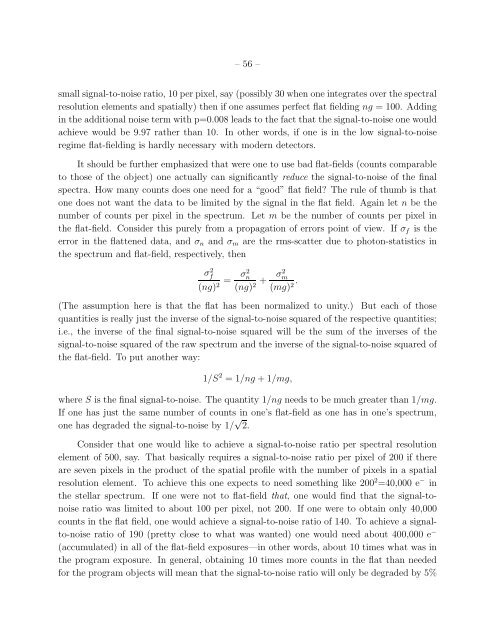Astronomical Spectroscopy - Physics - University of Cincinnati
Astronomical Spectroscopy - Physics - University of Cincinnati
Astronomical Spectroscopy - Physics - University of Cincinnati
You also want an ePaper? Increase the reach of your titles
YUMPU automatically turns print PDFs into web optimized ePapers that Google loves.
– 56 –<br />
small signal-to-noise ratio, 10 per pixel, say (possibly 30 when one integrates over the spectral<br />
resolution elements and spatially) then if one assumes perfect flat fielding ng = 100. Adding<br />
in the additional noise term with p=0.008 leads to the fact that the signal-to-noise one would<br />
achieve would be 9.97 rather than 10. In other words, if one is in the low signal-to-noise<br />
regime flat-fielding is hardly necessary with modern detectors.<br />
It should be further emphasized that were one to use bad flat-fields (counts comparable<br />
to those <strong>of</strong> the object) one actually can significantly reduce the signal-to-noise <strong>of</strong> the final<br />
spectra. How many counts does one need for a “good” flat field The rule <strong>of</strong> thumb is that<br />
one does not want the data to be limited by the signal in the flat field. Again let n be the<br />
number <strong>of</strong> counts per pixel in the spectrum. Let m be the number <strong>of</strong> counts per pixel in<br />
the flat-field. Consider this purely from a propagation <strong>of</strong> errors point <strong>of</strong> view. If σ f is the<br />
error in the flattened data, and σ n and σ m are the rms-scatter due to photon-statistics in<br />
the spectrum and flat-field, respectively, then<br />
σ 2 f<br />
(ng) 2 =<br />
σ2 n<br />
(ng) 2 + σ2 m<br />
(mg) 2.<br />
(The assumption here is that the flat has been normalized to unity.) But each <strong>of</strong> those<br />
quantities is really just the inverse <strong>of</strong> the signal-to-noise squared <strong>of</strong> the respective quantities;<br />
i.e., the inverse <strong>of</strong> the final signal-to-noise squared will be the sum <strong>of</strong> the inverses <strong>of</strong> the<br />
signal-to-noise squared <strong>of</strong> the raw spectrum and the inverse <strong>of</strong> the signal-to-noise squared <strong>of</strong><br />
the flat-field. To put another way:<br />
1/S 2 = 1/ng + 1/mg,<br />
where S is the final signal-to-noise. The quantity 1/ng needs to be much greater than 1/mg.<br />
If one has just the same number <strong>of</strong> counts in one’s flat-field as one has in one’s spectrum,<br />
one has degraded the signal-to-noise by 1/ √ 2.<br />
Consider that one would like to achieve a signal-to-noise ratio per spectral resolution<br />
element <strong>of</strong> 500, say. That basically requires a signal-to-noise ratio per pixel <strong>of</strong> 200 if there<br />
are seven pixels in the product <strong>of</strong> the spatial pr<strong>of</strong>ile with the number <strong>of</strong> pixels in a spatial<br />
resolution element. To achieve this one expects to need something like 200 2 =40,000 e − in<br />
the stellar spectrum. If one were not to flat-field that, one would find that the signal-tonoise<br />
ratio was limited to about 100 per pixel, not 200. If one were to obtain only 40,000<br />
counts in the flat field, one would achieve a signal-to-noise ratio <strong>of</strong> 140. To achieve a signalto-noise<br />
ratio <strong>of</strong> 190 (pretty close to what was wanted) one would need about 400,000 e −<br />
(accumulated) in all <strong>of</strong> the flat-field exposures—in other words, about 10 times what was in<br />
the program exposure. In general, obtaining 10 times more counts in the flat than needed<br />
for the program objects will mean that the signal-to-noise ratio will only be degraded by 5%

















